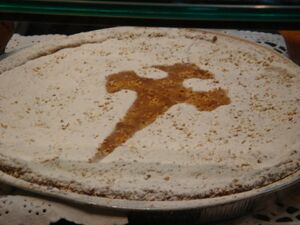Tarta de Santiago
Description
A traditional Galician cake made using almonds, sugar and eggs as described below.
Sensory characteristics
— Shape: round with a dusting of icing sugar showing, as a distinguishing mark, the Cross of the Order of Santiago.
— Aroma: that of egg yolk and almonds.
— Colour: white on the surface, due to the decorative dusting of icing sugar and golden inside.
— Taste: that of almonds.
— Texture: spongy and granulated.
- Presentation: there are two basic presentations: with and without a base. Each of them comes in different sizes.
Raw materials (for processed products only)
The ingredients used to make Tarta de Santiago (without a base or excluding the base) are:
— high-quality almonds, which must account for at least 33 % of the total weight of the mix. These almonds must have a fat content of more than 50 % measured in the untrimmed product. This specification is generally met by Mediterranean almond varieties (including the varieties ‘Comuna’, ‘Marcona’, ‘Mollar’ ‘Largueta’ and ‘Planeta’), which are the varieties normally used
— refined sugar (sucrose), which must account for at least 33 % of the total weight of the mix
— eggs, which must account for at least 25 % of the total weight of the mix
— lemon zest and icing sugar, sweet wine, brandy or grape marc, depending on the recipe used.
For the cake with a base, the latter must not account for more than 25 % of the weight of the cake and may be made of:
— puff pastry made from wheat, butter, water and salt, or
— shortcrust pastry made from wheat flour, butter, refined sugar (sucrose), whole eggs, milk and salt.
Specific rules concerning slicing, grating, packaging, etc
Packaging must take place in the production facilities indicated in the register kept by the Regulatory Board. Packaging must be carried out at the production site firstly because the product is a very fragile cake which is crumbly and has a coating of icing sugar, making it difficult to handle and transport the product without the protection provided by the packaging itself. Secondly, to preserve hygiene and avoid contamination. The packaging process can therefore be said to be part of the production process. The packaging used must be new, clean, separate for each unit and made of materials suitable for storing and transporting the product.
Geographical area
The geographical area of the Protected Geographical Indication ‘Tarta de Santiago’ covers the entire area of the Autonomous Community of Galicia.
Link with the geographical area
Products made from almonds have been consumed in Galicia since ancient times, giving rise to a traditional cake which is now part of Galician cuisine, even though the region itself has few almond trees. These almond-based products were originally eaten by the upper classes. They later gained popularity among the general population and are now a typical and traditional Galician dessert, ‘Tarta de Santiago’ being one of the oldest traditional specialities of Galician baking. ‘Tarta de Santiago’ is a dessert which is clearly different in terms of both its appearance and taste as well as its colour and spongy, granulated texture. Its shape and the Cross of the Order of Santiago on top make this cake easy to recognise.
The oldest reference to the manufacture and consumption of almond sponge cake, known today as ‘Tarta de Santiago’, dates back to 1577 in the context of a visit by Don Pedro de Portocarrero to the University of Santiago de Compostela and his study of the meals provided for the professors during the ceremony for the award of degrees.
The first reliable recipes appeared in the Cuaderno de confitería, which was compiled by Luis Bartolomé de Leybar around 1838, and El confitero y el pastelero, a book by Eduardo Merín which was very useful for cooks, innkeepers and confectioners. The chronology of these works and their unmistakeably Galician origin confirm both how far the preparation goes back in time and its link to local gastronomic traditions. The fact that this cake did not appear in cookery books elsewhere in Spain until the 20th century shows that it was not considered to be part of the national baking heritage and that it was long regarded as a regional speciality. This all lends weight to the argument that the cake is of Galician origin and strengthens its close link to tradition, gastronomy and taste in Galicia.
Furthermore, in traditional Galician cake shops ‘Tarta de Santiago’ is still made using recipes dating back to at least the end of the 19th century. The founder of ‘Casa Mora’, a cake shop in Santiago de Compostela, started decorating the almond cakes with a silhouette of the Cross of Saint James in 1924. This idea was a great success and soon spread throughout Galicia. Lastly, in the Spanish Inventory of Traditional Products published by the Ministry of Agriculture, Fisheries and Food in 1996, ‘Tarta de Santiago’ appears in the section on pastry makers’ products, which is further proof of the product's link to the Autonomous Community of Galicia.
Reference: The European Commission
#tartadesantiago #almonds #almond #icingsugar #eggs #wheat #butter #flour #pastry #shortcrustpastry #fat https://www.cookipedia.co.uk/recipes_wiki/Tarta_de_Santiago
